2010 MERCEDES-BENZ R320 fold seats
[x] Cancel search: fold seatsPage 17 of 364
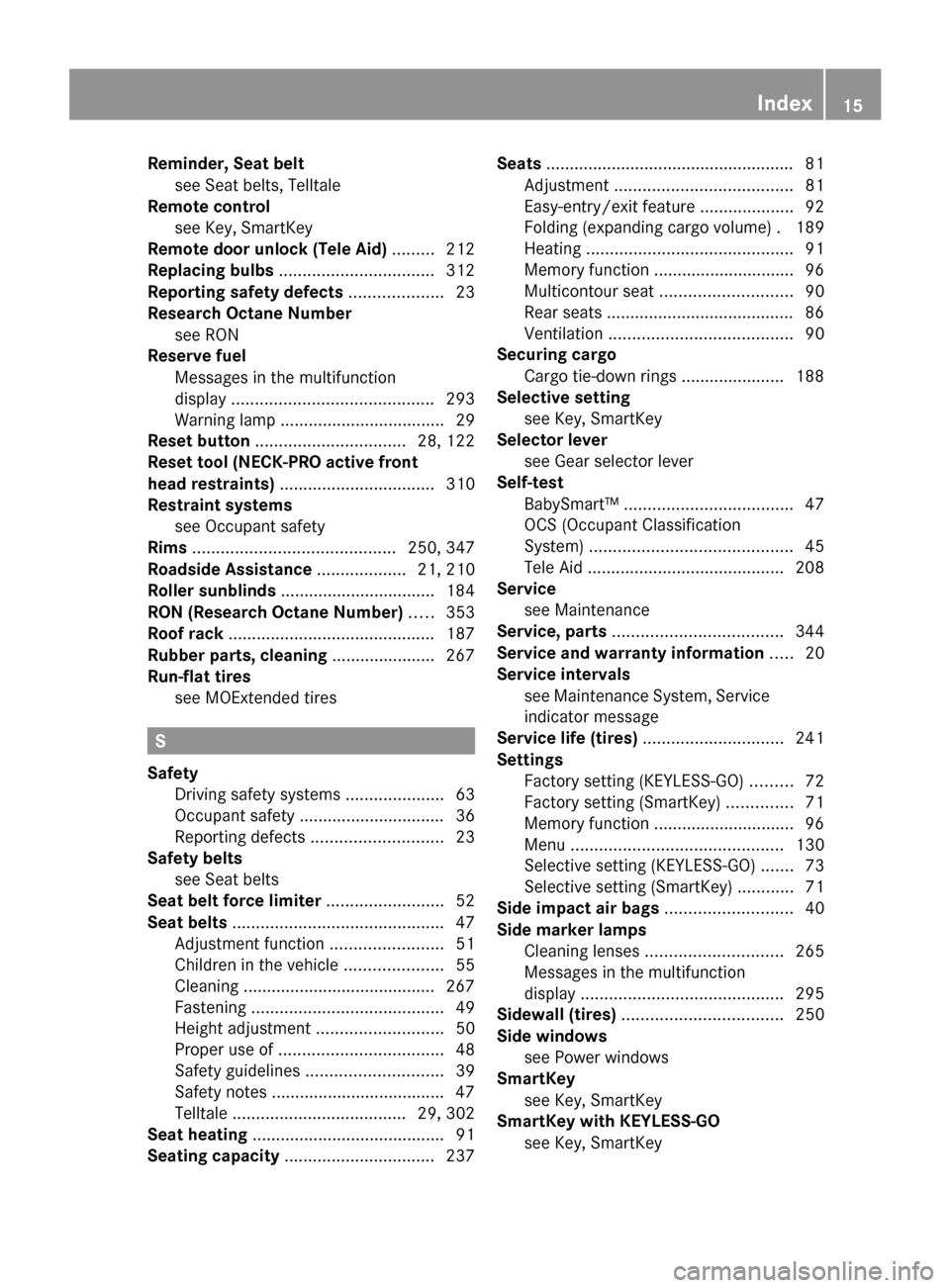
Reminder, Seat belt
see Seat belts, Telltale
Remote control
see Key, SmartKey
Remote door unlock (Tele Aid) .........212
Replacing bulbs ................................. 312
Reporting safety defects .................... 23
Research Octane Number see RON
Reserve fuel
Messages in the multifunction
display ........................................... 293
Warning lamp ................................... 29
Reset button ................................ 28, 122
Reset tool (NECK-PRO active front
head restraints) ................................. 310
Restraint systems see Occupant safety
Rims ........................................... 250, 347
Roadside Assistance ...................21, 210
Roller sunblinds ................................. 184
RON (Research Octane Number) ..... 353
Roof rack ............................................ 187
Rubber parts, cleaning ...................... 267
Run-flat tires see MOExtended tires S
Safety Driving safety systems ..................... 63
Occupant safety ...............................
36
Reporting defects ............................ 23
Safety belts
see Seat belts
Seat belt force limiter ......................... 52
Seat belts ............................................. 47
Adjustment function ........................51
Children in the vehicle .....................55
Cleaning ......................................... 267
Fastening ......................................... 49
Height adjustment ...........................50
Proper use of ................................... 48
Safety guidelines ............................. 39
Safety notes ..................................... 47
Telltale ..................................... 29, 302
Seat heating ......................................... 91
Seating capacity ................................ 237Seats .....................................................
81
Adjustment ...................................... 81
Easy-entry/exit feature ....................92
Folding (expanding cargo volume) . 189
Heating ............................................ 91
Memory function .............................. 96
Multicontour seat ............................ 90
Rear seats ........................................ 86
Ventilation ....................................... 90
Securing cargo
Cargo tie-down rings ...................... 188
Selective setting
see Key, SmartKey
Selector lever
see Gear selector lever
Self-test
BabySmart™ .................................... 47
OCS (Occupant Classification
System) ........................................... 45
Tele Aid .......................................... 208
Service
see Maintenance
Service, parts .................................... 344
Service and warranty information .....20
Service intervals see Maintenance System, Service
indicator message
Service life (tires) .............................. 241
Settings Factory setting (KEYLESS-GO) ......... 72
Factory setting (SmartKey) ..............71
Memory function .............................. 96
Menu ............................................. 130
Selective setting (KEYLESS-GO) ....... 73
Selective setting (SmartKey) ............71
Side impact air bags ...........................40
Side marker lamps
Cleaning lenses ............................. 265
Messages in the multifunction
display ........................................... 295
Sidewall (tires) .................................. 250
Side windows see Power windows
SmartKey
see Key, SmartKey
SmartKey with KEYLESS-GO
see Key, SmartKey Index
15 251_AKB; 4; 52, en-US
d2ureepe,
Version: 2.11.8.1 2009-03-23T09:22:52+01:00 - Seite 15
Page 60 of 364

Top tether straps enable an additional
connection to be made between child
restraint systems secured with LATCH-type
anchors and rear seats. This can further
reduce the risk of injury.
G
Observe Safety notes, see page 55.
Outboard second-row and third-row seats X
Press in lower part of anchorage ring
cover : on the seat backrest on which a
child seat is to be installed.
X Pull on upper part of anchorage ring
cover : to remove cover.
X Store anchorage ring cover : in a
convenient place (e.g. glove box).
X Move the respective head restraint to its
uppermost position ( Y page 88).
X Release the respective seat backrest
(Y page 84).
The seat backrest folds down.
X Guide the top tether strap between head
restraint and top of the seat backrest. X
Securely fasten hook =, which is part of
the tether strap ?, to anchorage ring ;. i
For safety, make sure hook = is attached
to anchorage ring ; beyond the safety
catch, as illustrated.
Make sure
R top tether strap ? is not twisted
R the head restraint is installed and
positioned such that top tether strap ?
can pass freely between the head restraint
and top of the seat backrest
R top tether strap ? is positioned between
the seat backrest and the cargo
compartment cover blind (if installed)
R top tether strap ? is positioned between
the seat backrest and the cargo net (if
installed) G
Warning!
When installing a child seat on a third-row
seat, do not fasten the hook to the strap below
the anchorage ring. Otherwise, the child seat
will not be securely fastened. A child’s risk of
serious or fatal injuries is significantly
increased if the child seat is not properly
secured in the vehicle.
X Fold seat backrest up and push backwards
until it engages audibly.
An outboard second-row seat is locked
properly only when the lock status
indicator is in hinged position and the red
marking is barely visible ( Y page 86).58
Occupant safetySafety and security
251_AKB; 4; 52, en-US
d2ureepe,
Version: 2.11.8.1 2009-03-23T09:22:52+01:00 - Seite 58
Page 61 of 364
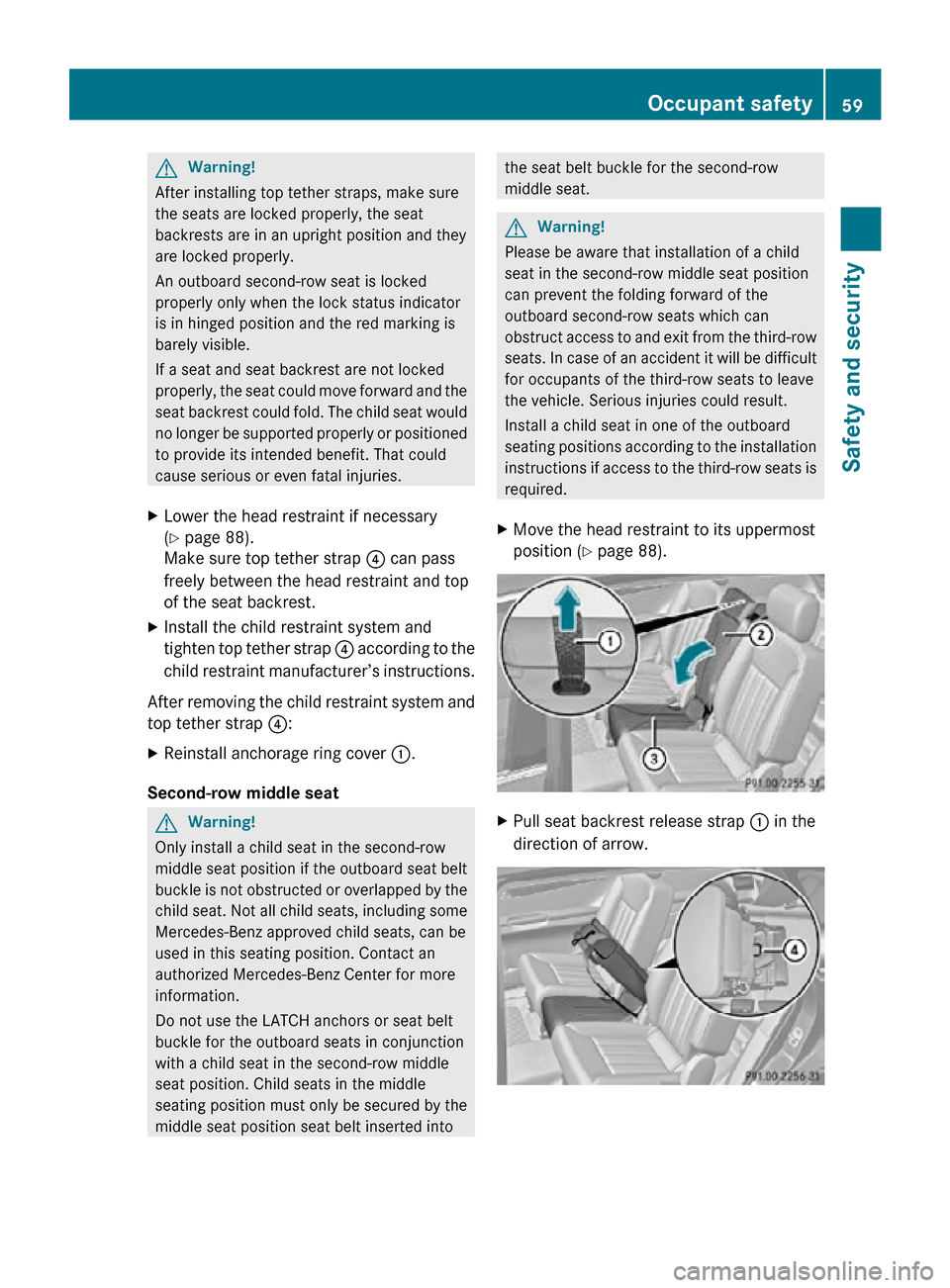
G
Warning!
After installing top tether straps, make sure
the seats are locked properly, the seat
backrests are in an upright position and they
are locked properly.
An outboard second-row seat is locked
properly only when the lock status indicator
is in hinged position and the red marking is
barely visible.
If a seat and seat backrest are not locked
properly, the seat could move forward and the
seat backrest could fold. The child seat would
no longer be supported properly or positioned
to provide its intended benefit. That could
cause serious or even fatal injuries.
X Lower the head restraint if necessary
(Y page 88).
Make sure top tether strap ? can pass
freely between the head restraint and top
of the seat backrest.
X Install the child restraint system and
tighten top tether strap ? according to the
child restraint manufacturer’s instructions.
After removing the child restraint system and
top tether strap ?:
X Reinstall anchorage ring cover :.
Second-row middle seat G
Warning!
Only install a child seat in the second-row
middle seat position if the outboard seat belt
buckle is not obstructed or overlapped by the
child seat. Not all child seats, including some
Mercedes-Benz approved child seats, can be
used in this seating position. Contact an
authorized Mercedes-Benz Center for more
information.
Do not use the LATCH anchors or seat belt
buckle for the outboard seats in conjunction
with a child seat in the second-row middle
seat position. Child seats in the middle
seating position must only be secured by the
middle seat position seat belt inserted into the seat belt buckle for the second-row
middle seat.
G
Warning!
Please be aware that installation of a child
seat in the second-row middle seat position
can prevent the folding forward of the
outboard second-row seats which can
obstruct access to and exit from the third-row
seats. In case of an accident it will be difficult
for occupants of the third-row seats to leave
the vehicle. Serious injuries could result.
Install a child seat in one of the outboard
seating positions according to the installation
instructions if access to the third-row seats is
required.
X Move the head restraint to its uppermost
position (Y page 88). X
Pull seat backrest release strap : in the
direction of arrow. Occupant safety
59Safety and security
251_AKB; 4; 52, en-US
d2ureepe, Version: 2.11.8.1 2009-03-23T09:22:52+01:00 - Seite 59 Z
Page 62 of 364
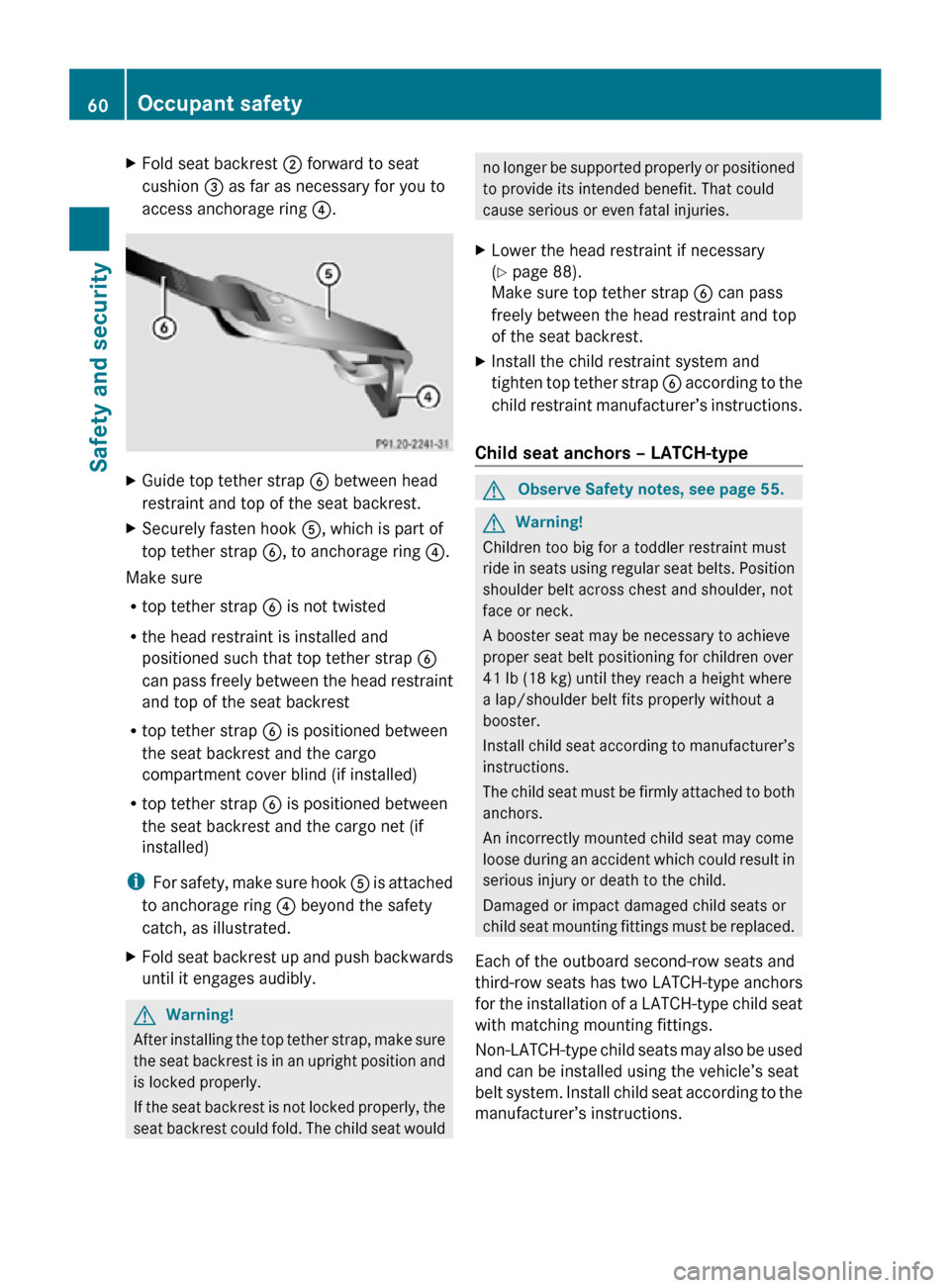
X
Fold seat backrest ; forward to seat
cushion = as far as necessary for you to
access anchorage ring ?. X
Guide top tether strap B between head
restraint and top of the seat backrest.
X Securely fasten hook A, which is part of
top tether strap B, to anchorage ring ?.
Make sure
R top tether strap B is not twisted
R the head restraint is installed and
positioned such that top tether strap B
can pass freely between the head restraint
and top of the seat backrest
R top tether strap B is positioned between
the seat backrest and the cargo
compartment cover blind (if installed)
R top tether strap B is positioned between
the seat backrest and the cargo net (if
installed)
i For safety, make sure hook A is attached
to anchorage ring ? beyond the safety
catch, as illustrated.
X Fold seat backrest up and push backwards
until it engages audibly. G
Warning!
After installing the top tether strap, make sure
the seat backrest is in an upright position and
is locked properly.
If the seat backrest is not locked properly, the
seat backrest could fold. The child seat would no longer be supported properly or positioned
to provide its intended benefit. That could
cause serious or even fatal injuries.
X Lower the head restraint if necessary
(Y page 88).
Make sure top tether strap B can pass
freely between the head restraint and top
of the seat backrest.
X Install the child restraint system and
tighten top tether strap B according to the
child restraint manufacturer’s instructions.
Child seat anchors – LATCH-type G
Observe Safety notes, see page 55. G
Warning!
Children too big for a toddler restraint must
ride in seats using regular seat belts. Position
shoulder belt across chest and shoulder, not
face or neck.
A booster seat may be necessary to achieve
proper seat belt positioning for children over
41 lb (18 kg) until they reach a height where
a lap/shoulder belt fits properly without a
booster.
Install child seat according to manufacturer’s
instructions.
The child seat must be firmly attached to both
anchors.
An incorrectly mounted child seat may come
loose during an accident which could result in
serious injury or death to the child.
Damaged or impact damaged child seats or
child seat mounting fittings must be replaced.
Each of the outboard second-row seats and
third-row seats has two LATCH-type anchors
for the installation of a LATCH-type child seat
with matching mounting fittings.
Non-LATCH-type child seats may also be used
and can be installed using the vehicle’s seat
belt system. Install child seat according to the
manufacturer’s instructions. 60
Occupant safetySafety and security
251_AKB; 4; 52, en-US
d2ureepe,
Version: 2.11.8.1 2009-03-23T09:22:52+01:00 - Seite 60
Page 84 of 364
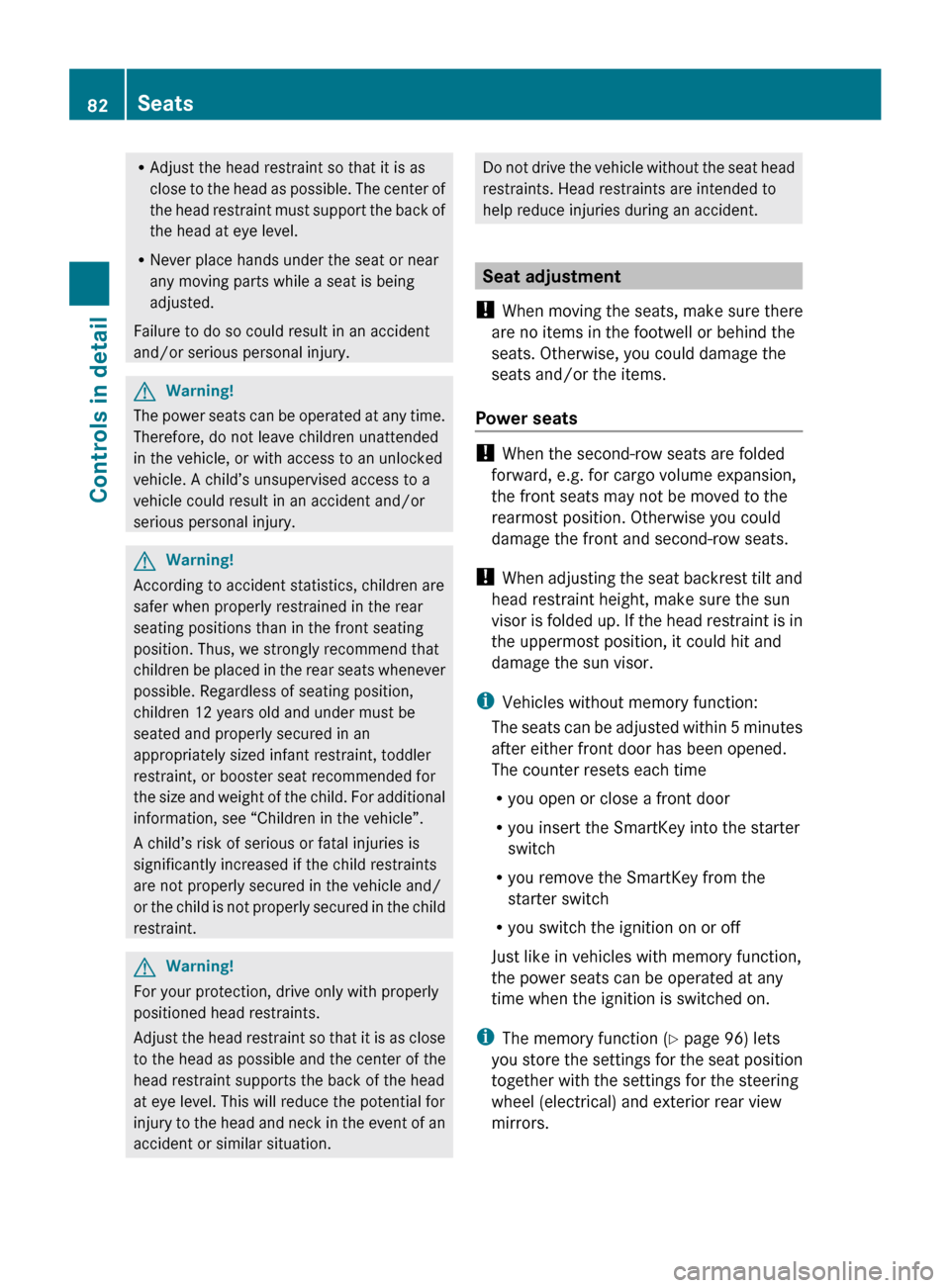
R
Adjust the head restraint so that it is as
close
to the head as possible. The center of
the head restraint must support the back of
the head at eye level.
R Never place hands under the seat or near
any moving parts while a seat is being
adjusted.
Failure to do so could result in an accident
and/or serious personal injury. G
Warning!
The power seats can be operated at any time.
Therefore, do not leave children unattended
in the vehicle, or with access to an unlocked
vehicle. A child’s unsupervised access to a
vehicle could result in an accident and/or
serious personal injury. G
Warning!
According to accident statistics, children are
safer when properly restrained in the rear
seating positions than in the front seating
position. Thus, we strongly recommend that
children
be placed in the rear seats whenever
possible. Regardless of seating position,
children 12 years old and under must be
seated and properly secured in an
appropriately sized infant restraint, toddler
restraint, or booster seat recommended for
the size and weight of the child. For additional
information, see “Children in the vehicle”.
A child’s risk of serious or fatal injuries is
significantly increased if the child restraints
are not properly secured in the vehicle and/
or the child is not properly secured in the child
restraint. G
Warning!
For your protection, drive only with properly
positioned head restraints.
Adjust
the head restraint so that it is as close
to the head as possible and the center of the
head restraint supports the back of the head
at eye level. This will reduce the potential for
injury to the head and neck in the event of an
accident or similar situation. Do not drive the vehicle without the seat head
restraints. Head restraints are intended to
help reduce injuries during an accident.
Seat adjustment
! When moving the seats, make sure there
are no items in the footwell or behind the
seats. Otherwise, you could damage the
seats and/or the items.
Power seats !
When the second-row seats are folded
forward, e.g. for cargo volume expansion,
the front seats may not be moved to the
rearmost position. Otherwise you could
damage the front and second-row seats.
! When
adjusting the seat backrest tilt and
head restraint height, make sure the sun
visor is folded up. If the head restraint is in
the uppermost position, it could hit and
damage the sun visor.
i Vehicles without memory function:
The seats can be adjusted within 5 minutes
after either front door has been opened.
The counter resets each time
R you open or close a front door
R you insert the SmartKey into the starter
switch
R you remove the SmartKey from the
starter switch
R you switch the ignition on or off
Just like in vehicles with memory function,
the power seats can be operated at any
time when the ignition is switched on.
i The memory function (Y page 96) lets
you store the settings for the seat position
together with the settings for the steering
wheel (electrical) and exterior rear view
mirrors. 82
Seats
Controls in detail
251_AKB; 4; 52, en-US
d2ureepe,
Version: 2.11.8.1 2009-03-23T09:22:52+01:00 - Seite 82
Page 86 of 364
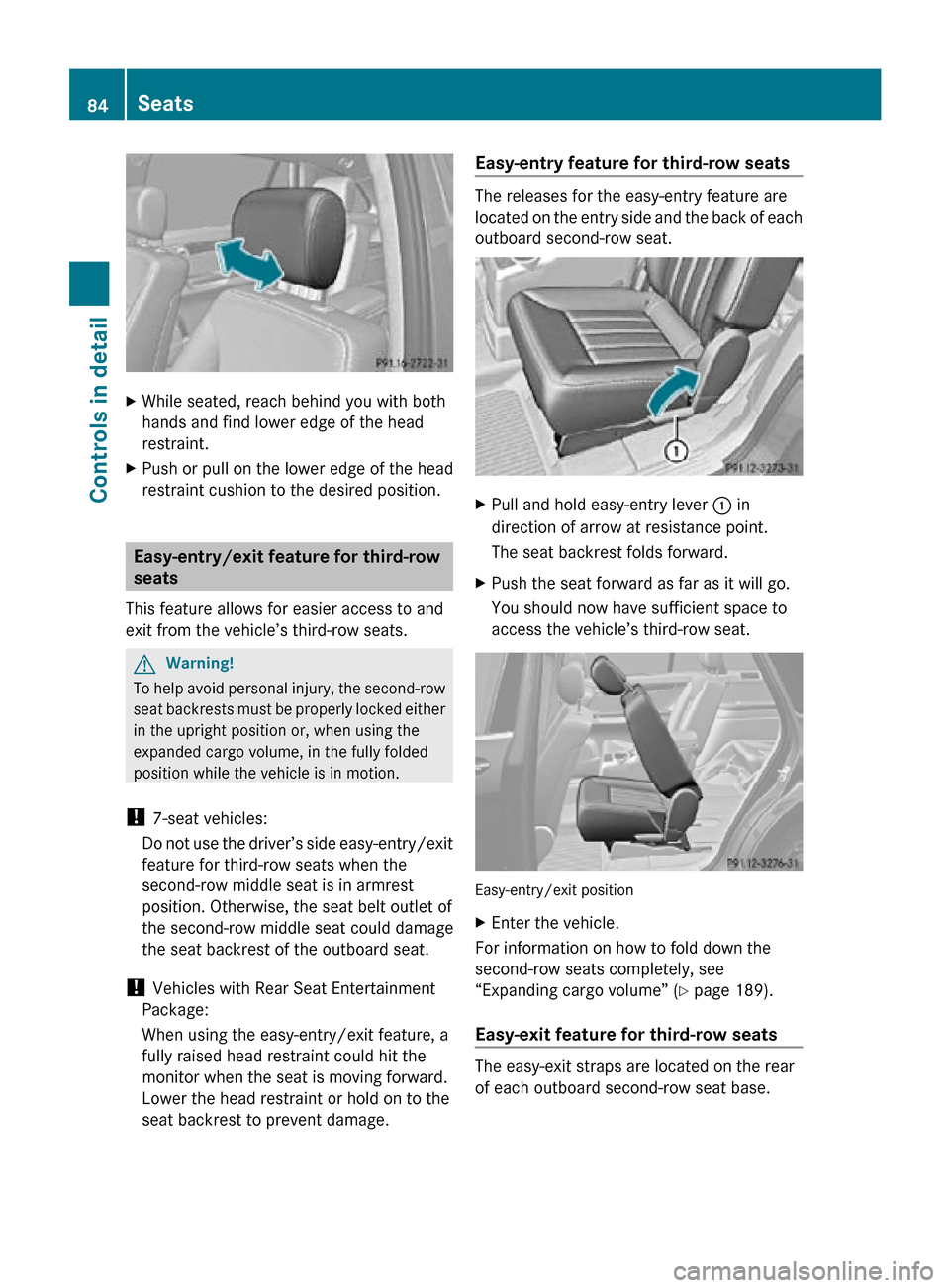
X
While seated, reach behind you with both
hands and find lower edge of the head
restraint.
X Push or pull on the lower edge of the head
restraint cushion to the desired position. Easy-entry/exit feature for third-row
seats
This feature allows for easier access to and
exit from the vehicle’s third-row seats. G
Warning!
To help avoid personal injury, the second-row
seat backrests must be properly locked either
in the upright position or, when using the
expanded cargo volume, in the fully folded
position while the vehicle is in motion.
! 7-seat vehicles:
Do not use the driver’s side easy-entry/exit
feature for third-row seats when the
second-row middle seat is in armrest
position. Otherwise, the seat belt outlet of
the second-row middle seat could damage
the seat backrest of the outboard seat.
! Vehicles with Rear Seat Entertainment
Package:
When using the easy-entry/exit feature, a
fully raised head restraint could hit the
monitor when the seat is moving forward.
Lower the head restraint or hold on to the
seat backrest to prevent damage. Easy-entry feature for third-row seats The releases for the easy-entry feature are
located on the entry side and the back of each
outboard second-row seat.
X
Pull and hold easy-entry lever : in
direction of arrow at resistance point.
The seat backrest folds forward.
X Push the seat forward as far as it will go.
You should now have sufficient space to
access the vehicle’s third-row seat. Easy-entry/exit position
X
Enter the vehicle.
For information on how to fold down the
second-row seats completely, see
“Expanding cargo volume” ( Y page 189).
Easy-exit feature for third-row seats The easy-exit straps are located on the rear
of each outboard second-row seat base.84
SeatsControls in detail
251_AKB; 4; 52, en-US
d2ureepe,
Version: 2.11.8.1 2009-03-23T09:22:52+01:00 - Seite 84
Page 87 of 364
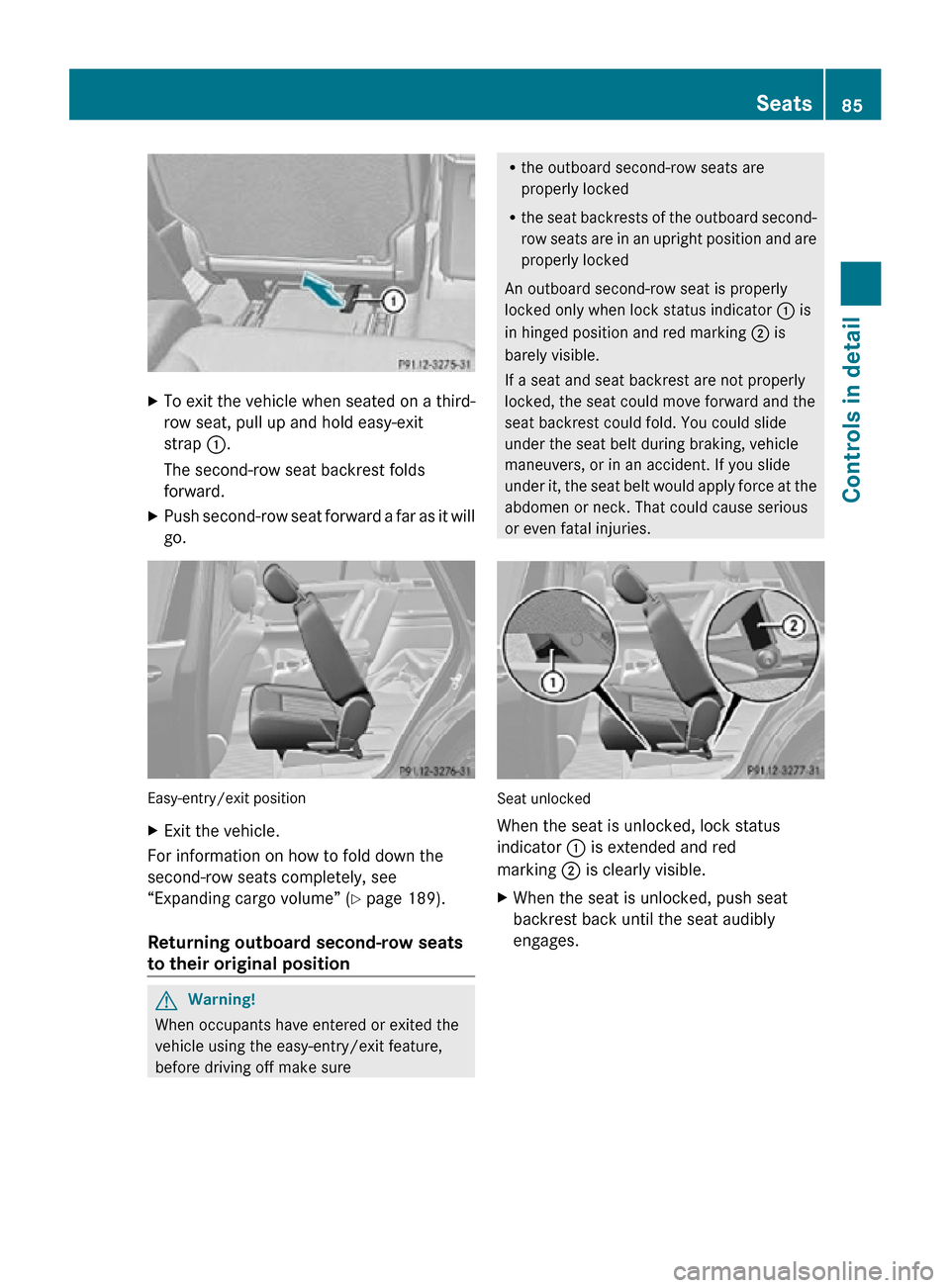
X
To exit the vehicle when seated on a third-
row seat, pull up and hold easy-exit
strap :.
The second-row seat backrest folds
forward.
X Push second-row seat forward a far as it will
go. Easy-entry/exit position
X
Exit the vehicle.
For information on how to fold down the
second-row seats completely, see
“Expanding cargo volume” ( Y page 189).
Returning outboard second-row seats
to their original position G
Warning!
When occupants have entered or exited the
vehicle using the easy-entry/exit feature,
before driving off make sure R
the outboard second-row seats are
properly locked
R the seat backrests of the outboard second-
row seats are in an upright position and are
properly locked
An outboard second-row seat is properly
locked only when lock status indicator : is
in hinged position and red marking ; is
barely visible.
If a seat and seat backrest are not properly
locked, the seat could move forward and the
seat backrest could fold. You could slide
under the seat belt during braking, vehicle
maneuvers, or in an accident. If you slide
under it, the seat belt would apply force at the
abdomen or neck. That could cause serious
or even fatal injuries. Seat unlocked
When the seat is unlocked, lock status
indicator : is extended and red
marking ; is clearly visible.
X
When the seat is unlocked, push seat
backrest back until the seat audibly
engages. Seats
85Controls in detail
251_AKB; 4; 52, en-US
d2ureepe, Version: 2.11.8.1 2009-03-23T09:22:52+01:00 - Seite 85 Z
Page 88 of 364
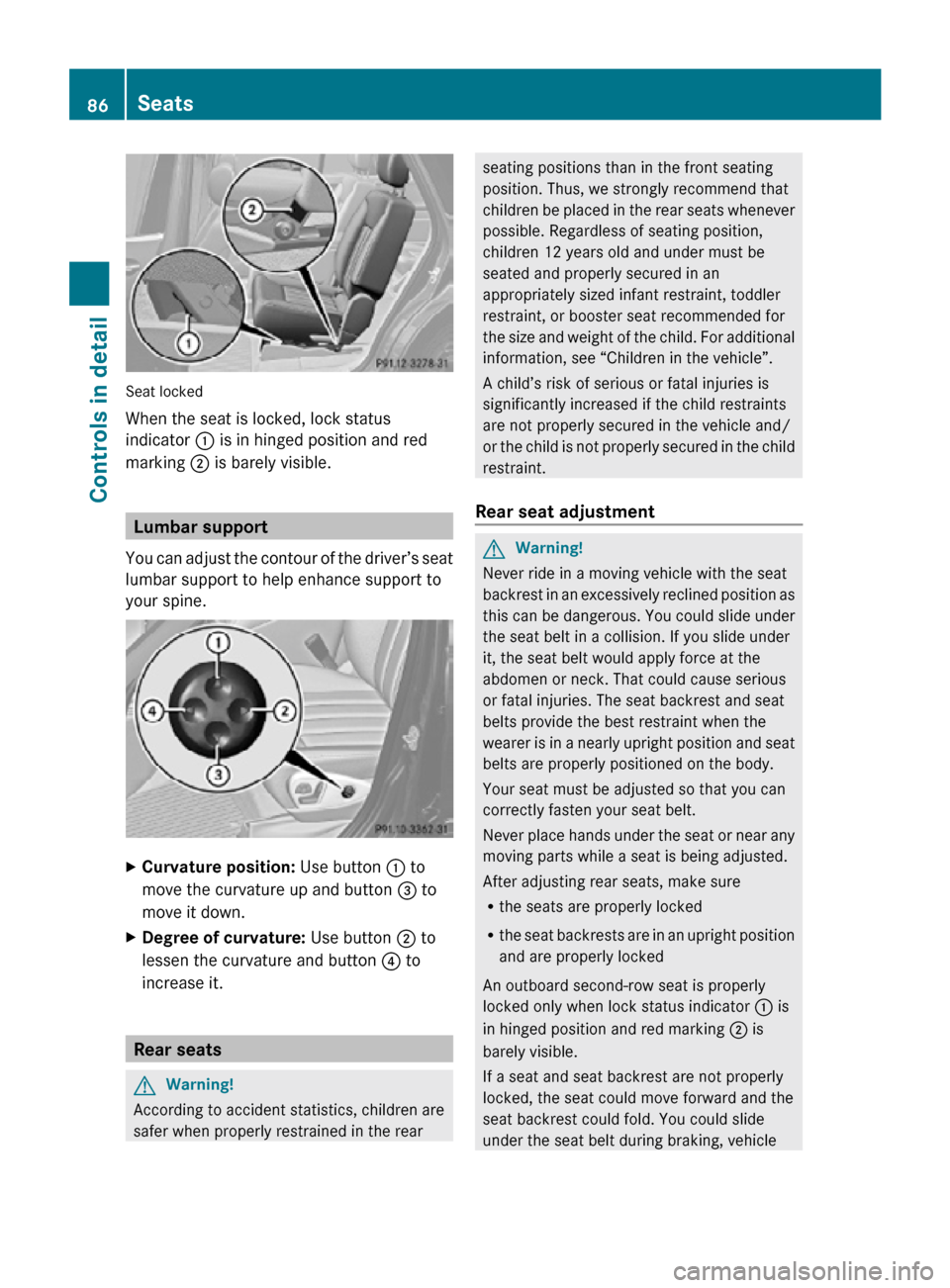
Seat locked
When the seat is locked, lock status
indicator : is in hinged position and red
marking ; is barely visible.
Lumbar support
You can adjust the contour of the driver’s seat
lumbar support to help enhance support to
your spine. X
Curvature position: Use button : to
move the curvature up and button = to
move it down.
X Degree of curvature: Use button ; to
lessen the curvature and button ? to
increase it. Rear seats
G
Warning!
According to accident statistics, children are
safer when properly restrained in the rear seating positions than in the front seating
position. Thus, we strongly recommend that
children be placed in the rear seats whenever
possible. Regardless of seating position,
children 12 years old and under must be
seated and properly secured in an
appropriately sized infant restraint, toddler
restraint, or booster seat recommended for
the size and weight of the child. For additional
information, see “Children in the vehicle”.
A child’s risk of serious or fatal injuries is
significantly increased if the child restraints
are not properly secured in the vehicle and/
or the child is not properly secured in the child
restraint.
Rear seat adjustment G
Warning!
Never ride in a moving vehicle with the seat
backrest in an excessively reclined position as
this can be dangerous. You could slide under
the seat belt in a collision. If you slide under
it, the seat belt would apply force at the
abdomen or neck. That could cause serious
or fatal injuries. The seat backrest and seat
belts provide the best restraint when the
wearer is in a nearly upright position and seat
belts are properly positioned on the body.
Your seat must be adjusted so that you can
correctly fasten your seat belt.
Never place hands under the seat or near any
moving parts while a seat is being adjusted.
After adjusting rear seats, make sure
R the seats are properly locked
R the seat backrests are in an upright position
and are properly locked
An outboard second-row seat is properly
locked only when lock status indicator : is
in hinged position and red marking ; is
barely visible.
If a seat and seat backrest are not properly
locked, the seat could move forward and the
seat backrest could fold. You could slide
under the seat belt during braking, vehicle 86
SeatsControls in detail
251_AKB; 4; 52, en-US
d2ureepe,
Version: 2.11.8.1 2009-03-23T09:22:52+01:00 - Seite 86